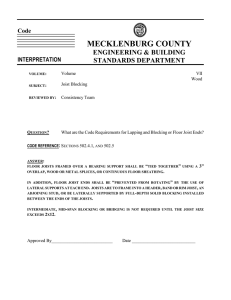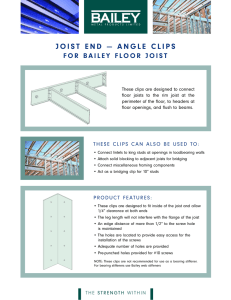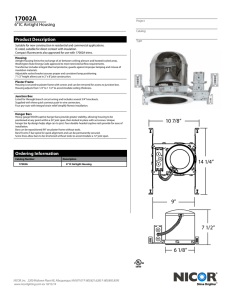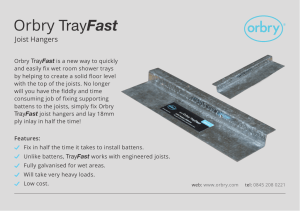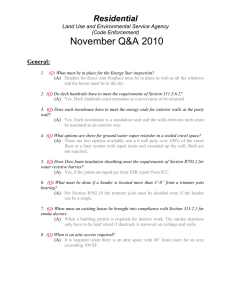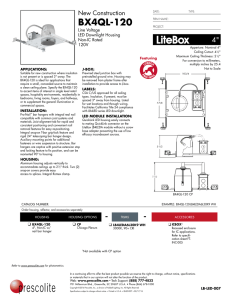110 - Floor Joist 2 Floor - Habitat for Humanity of the St. Vrain Valley
advertisement
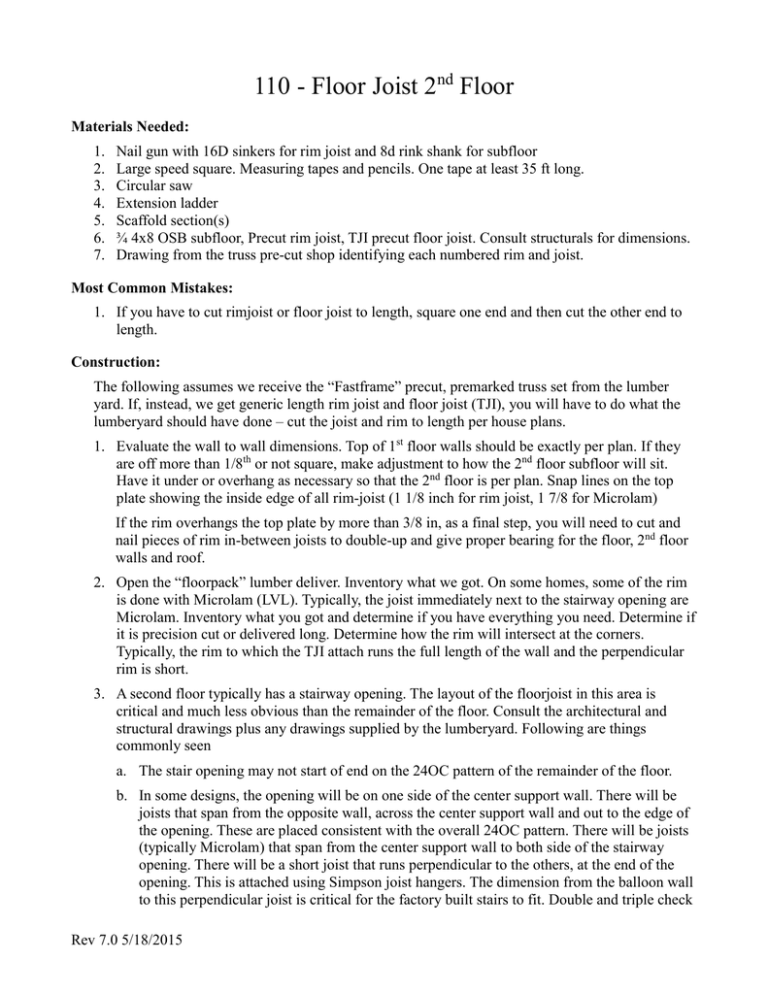
110 - Floor Joist 2nd Floor Materials Needed: 1. 2. 3. 4. 5. 6. 7. Nail gun with 16D sinkers for rim joist and 8d rink shank for subfloor Large speed square. Measuring tapes and pencils. One tape at least 35 ft long. Circular saw Extension ladder Scaffold section(s) ¾ 4x8 OSB subfloor, Precut rim joist, TJI precut floor joist. Consult structurals for dimensions. Drawing from the truss pre-cut shop identifying each numbered rim and joist. Most Common Mistakes: 1. If you have to cut rimjoist or floor joist to length, square one end and then cut the other end to length. Construction: The following assumes we receive the “Fastframe” precut, premarked truss set from the lumber yard. If, instead, we get generic length rim joist and floor joist (TJI), you will have to do what the lumberyard should have done – cut the joist and rim to length per house plans. 1. Evaluate the wall to wall dimensions. Top of 1st floor walls should be exactly per plan. If they are off more than 1/8th or not square, make adjustment to how the 2nd floor subfloor will sit. Have it under or overhang as necessary so that the 2nd floor is per plan. Snap lines on the top plate showing the inside edge of all rim-joist (1 1/8 inch for rim joist, 1 7/8 for Microlam) If the rim overhangs the top plate by more than 3/8 in, as a final step, you will need to cut and nail pieces of rim in-between joists to double-up and give proper bearing for the floor, 2nd floor walls and roof. 2. Open the “floorpack” lumber deliver. Inventory what we got. On some homes, some of the rim is done with Microlam (LVL). Typically, the joist immediately next to the stairway opening are Microlam. Inventory what you got and determine if you have everything you need. Determine if it is precision cut or delivered long. Determine how the rim will intersect at the corners. Typically, the rim to which the TJI attach runs the full length of the wall and the perpendicular rim is short. 3. A second floor typically has a stairway opening. The layout of the floorjoist in this area is critical and much less obvious than the remainder of the floor. Consult the architectural and structural drawings plus any drawings supplied by the lumberyard. Following are things commonly seen a. The stair opening may not start of end on the 24OC pattern of the remainder of the floor. b. In some designs, the opening will be on one side of the center support wall. There will be joists that span from the opposite wall, across the center support wall and out to the edge of the opening. These are placed consistent with the overall 24OC pattern. There will be joists (typically Microlam) that span from the center support wall to both side of the stairway opening. There will be a short joist that runs perpendicular to the others, at the end of the opening. This is attached using Simpson joist hangers. The dimension from the balloon wall to this perpendicular joist is critical for the factory built stairs to fit. Double and triple check Rev 7.0 5/18/2015 110 - Floor Joist 2nd Floor that you are getting this dimension correct c. In other designs, floor joists on each side of the stairway span from the exterior wall to interior support walls adjacent to the stairway. 4. Make layout marks. a. Starting at the rear of the house, make 24 OC layout marks on both sides and center wall of the house. 5. If you are working on the 1st unit (1st) of an n-plex, or a single family detached (SFD) home, you have access to all 4 sides of the floor. If you are working on the 2nd or later units (2nd) of an n-plex, you do not have access to one side of the floor. It is blocked by the firewall. This one side is typically one of the two perpendiculars to the floor joist. If work on adjacent units somehow got out of order, your might have firewall on both sides. If that is your case, the project is considerably harder. Consult the construction manager for instructions. 6. If you have access to all 4 sides of the home, do things in the following order a. Set full length floor joist. 1. If necessary, cut the full length floor joist to the width of the house minus the width of the rimjoist on both sides. 2. Lift the floor joist and position them in the proper areas. Start with them lying down. 3. One by one, stand the floor joist. Line them up on the chalk lines. Nail one side, then center, then other side. One nail on each side of bottom flange. b. Set rimjoist 1. As necessary, cut the rim joists to which the TJI attach to length. 2. Make layout marks on these rim joist to which the TJI attach. Mark both sides. 3. Lift these rim joist up on top of the TJI. Carefully, slide them into place drop them into the space adjacent to the TJI. Align each TJI to the layout marks on the rim. One worker is up on a step ladder pushing and pulling the TJI into place. Another worker is on an extension ladder putting one nail through the rim into the top and bottom flange of the TJI. Toenail the rim to the wall top plate every 8 inches. 4. Lift the rim joist that is parallel to the TJI up on top of the TJI. Then, carefully postion and drop in place. Toenail to the top plate, taking care to keep it properly aligned to the wall edge (or chalk line as set in the earlier step). c. Set the short floor joist that extend out to toward the stairway opening. Do not nail them at the center support wall. It will be some advantage while finishing the stairway opening to have this not nailed. d. Set any other short floor joist – such as might exist due to a jog in the exterior wall. 7. If you are working on the 2nd or later unit of a n-plex, you don’t have access to all 4 sides of the floor. a. Select the rim that is adjacent to the neighboring unit’s common wall. Attach Simpson A5 clips in-between each floor joist location using tico nails. Later, these A5 clips will be nailed Rev 7.0 5/18/2015 110 - Floor Joist 2nd Floor to the top plate, securing in place, the rimjoist at the common wall side. b. Snap a line the thickness of the rim joist from the edge of the top plate. c. You will have to temporarily suspend this rim joist about 2 feet in from the common wall. Attach floor joist shooting one nail through the rim into the top and in the bottom flange. Similarly, attach any rimjoist that runs parallel to the floorjoist. d. After attaching the floor joist, slide the assembly into place on the chalk line. e. Lift the rim that goes on the opposite side of the floor joist. Nail to the floor joist in the same way as above. Double check that joist are at 24 inch centers all across the floor and are not crooked. f. Toenail all rimjoist to the top plate. Nail every 8 inches. 8. Determine if there are any bump-outs in the floor plan. If yes, you may need to attach hangers to the last “normal” floorjoist. Check the structural drawings. This hangers may be attached upside down. Short, bump-out joist will sits in these hangers and extend out past the rimjoist and the wall. If blocking is required between these short bump-out joist, do not install that now. It will be installed, later, after insulation is done. 9. Build the stairway cutout. Review the architectural plans as to the dimensions of the cutout. a. As necessary, cut to length the floor joist that extend toward the stairway cutout. b. Mount hangers on the joist on either side of the stairway cutout. Slide the header into these hangers. c. Attach hangers to the header to support the TJI that extend toward the stairway cutout. Check square and nail everything to at the center beam. Rev 7.0 5/18/2015 110 - Floor Joist 2nd Floor Safety 2 Fall From Height Fall while setting 2nd floor floor & rim joist Do not walk on tops of walls! Do all work from step ladders or scaffolding. Do not lift rim joist in your arms while climbing a step ladder leaning on the house. The preferred solution is that the entire perimeter of the home is ringed with scaffolding. The scaffolding gives a secure place for workers attaching rim to floor joist. It also handles half of the fall risk (falling toward outside of house). The alternative is raise rimjoist by pushing it up on top of the floor joist. Then, from stepladders on the inside, slide it over into position. Then, nail rim to floorjoist from extension ladder or scaffold while others on stepladders inside continue to hold the rim upright. Continue on extension ladders or scaffold to toenail rimjoist to wall top plates. 39 Struck By Floor trusses dropped to 1st Depending on the sequence units in a n-plex are floor while putting together assembled, you may find that the floor joist and the 2nd floor joist assembly rim joist assembly for a unit may have to be assembled while slid off a few feet to one side. Then, the assembly must be slid into final position. During this sliding, this assembly could fall off the edge, come apart and fall on someone. Keep all but the floor truss crew out of the drop zone. Nail up some blocks or use other means to insure that long rim joist that are nailed into the assembly do not go crooked and slide off the wall they are sitting on. When truss/rim assembly is being slid into place adjacent to the common wall, keep good communications among team that it is moved evenly and sections do not come apart. Rev 7.0 5/18/2015 110 - Floor Joist 2nd Floor 44 Struck By Nail gun Safety Glasses Required All guns must be in single shot mode. No bump fire guns Air hose must be disconnected during any servicing, unjamming, etc Never shoot toward yourself or anyone else. If you must hold one of the pieces of wood being nailed together, be sure your hand is at least 1 ft from the shooting tip of the gun 46 Struck By Power tools sawdust or other Safety Glasses required with any power tools objects shot toward eyes 47 Tools - Hand Circular Saw - wood propped and Power between 2 supports, cut in the middle, blade is pinched, kickback causes injury When using a circular saw, short end of the cut is left to fall away. Do not make a cut in-between 2 supported ends. If someone is holding the dropaway end, he/she must lightly support it, letting it sag as the cut is made No cutting with wood propped over a worker’s foot or supported by hand. 48 Tools - Hand Circular Saw - arms, legs etc and Power too close to cut Common practice among carpenters is to support the cut with their foot. This is not accepted practice at Habitat. Cut to be done on saw horses or otherwise supported away from body I have heard and understood the briefings on how to use the tools required for this activity. I have heard and understood the methods we use to do this activity Date ___________________________ _________________ Instructor Name _________________________ Signature _________________________ Name _________________________ Signature Rev 7.0 5/18/2015
